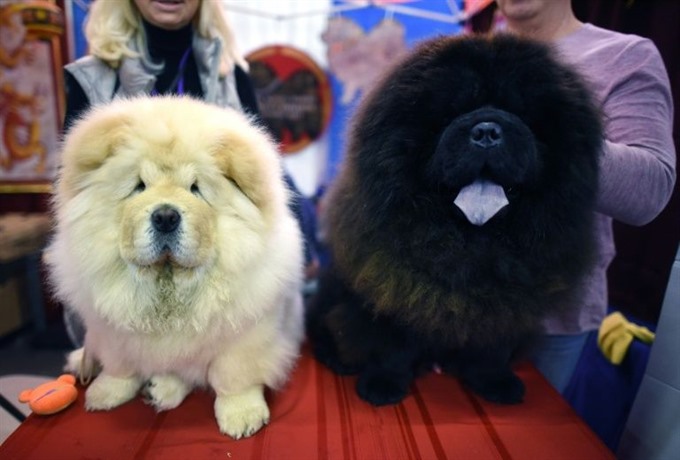 Life & Style
Life & Style

Hailing from every corner of the United States and coming as far afield as Japan and Russia, some 2,800 dogs will square off starting Monday at the Westminster Dog Show.
 |
| Two Chow Chows are seen at the 9th AKC Meet The Breeds February 10, at the 142nd Annual Westminster Kennel Club Dog Show. — AFP Photo |
NEW YORK — Hailing from every corner of the United States and coming as far afield as Japan and Russia, some 2,800 dogs will square off starting Monday at the Westminster Dog Show.
The 142nd installment of the storied canine beauty contest, the oldest continuously run US sporting event after the Kentucky Derby, culminates Tuesday night with the selection of Best in Show at Madison Square Garden.
But before that dramatic unveiling, the field will be winnowed in a series of preliminary faceoffs.
While the focus remains squarely on the canines, a species that includes Greyhounds and other four-legged speedsters, some of the most impressive hustle comes from the dogs’ human assistants, professional handlers who manage as many as 15 dogs apiece.
"We took three separate flights and everything to get all the dogs in here," said San Diego handler Bruce Schultz, whose cohort of eight dogs ranges in size from the petite Cavalier King Charles Spaniel to the Anatolian Shepherd and Bloodhound, both over 100 pounds.
"Tomorrow I’ll start at 6:00 am," Ohio-based Nina Fetter said Sunday, who is also showing eight dogs this year.
Fetter’s contestants run the gamut in size, shape and coiffure – ranging from the American Hairless Terrier to the Komondor, whose mop-like, all-white coat is a reliable scene-stealer.
"I do large to small, it’s pretty much whatever they pay me for," said Fetter.
Year-long circuit
Professional handlers have long been a fixture of the dog show circuit, which runs year-round. Some handlers charge US$500 per dog, plus expenses, to show at Westminster compared with $150 or $250 at smaller shows.
Many professionals in the business are second- and third-generation show dog people, while others grew up seeing dogs in functional roles, such as hunting or protecting cattle.
Hiring a professional handler is a way to ensure that a dog is adequately groomed and learns the basics of the ring, such as walking in a straight line, said Gail Miller Bisher, the communications director for the Westminster show.
"The advantage of a professional handler is they go to shows every weekend," Bisher said. "If you work in another profession, you may not be able to do that."
Stephen Cabral, a Los Angeles-area professional handler, used to work full time in health care and show dogs on weekends.
Nine years ago, he retired from his job of managing radiology tests and building MRI imaging machines to spend more time with his family.
"I’ve made as much money as in the hospitals," said Cabral, who drove across the country over four days this year with two dogs.
"You do it for the love"
Pivoting between breeds
Michigan handler Doug Belter presents most breeds, but generally refers Toys to other handlers who have succeeded with smaller dogs. He also avoids Poodles, which require an inordinate amount of shaving and primping.
His candidates this year include a Wire Fox Terrier and a Beagle, with whom he drove for 11 hours late last week.
Belter said the beagle must be presented in a much "softer" way compared with its pricklier colleague.
"If a beagle looks at you and you don’t melt, it’s not right," he said.
The fox terrier, by contrast, is supposed to show with hauteur and "almost a harsh look" in the eyes, consistent with its heritage as an animal bred to hunt foxes.
The Wire Fox Terrier "wants you to get out of her way and she will show herself," Belter said. "She’s a prima donna." — AFP

.jpg)


